Business Environment Analysis: Tesco and Welfare - Stakeholder Impact
VerifiedAdded on 2020/10/04
|9
|2887
|23
Report
AI Summary
This report examines the business environments of Tesco and a welfare charity, focusing on their organizational structures, purposes, and stakeholder influences. It analyzes the types of businesses, ownership structures, and the impact of various stakeholders such as customers, employees, and suppliers. The report compares the hierarchical structure of Tesco with the operational style of Asda, highlighting how economic environments, including growth and recession, affect their performance. Furthermore, it explores the impact of political, legal, and social factors on these businesses, providing a comprehensive overview of their operations and challenges within the broader business landscape. The report references various academic sources to support its analysis, offering a well-rounded perspective on the subject.
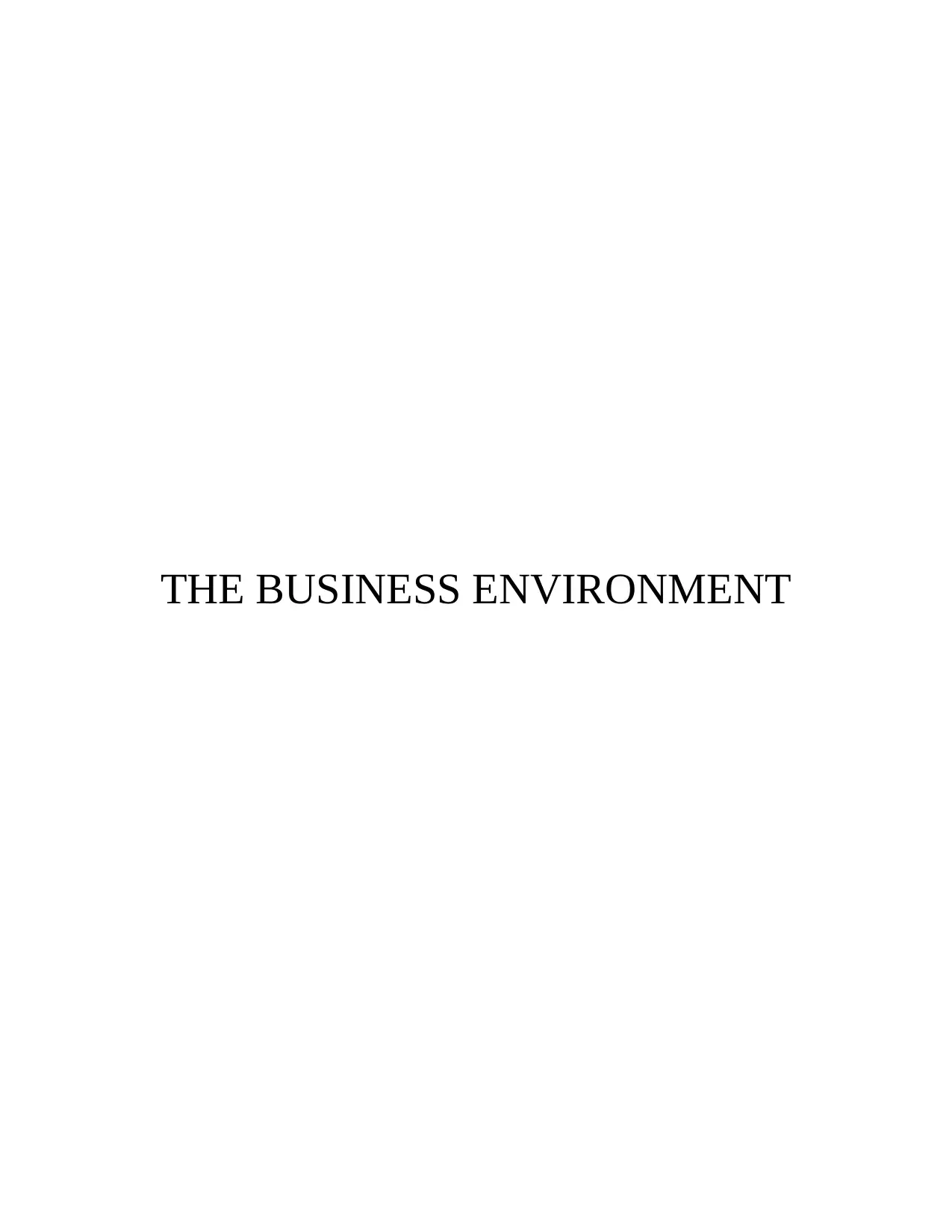
THE BUSINESS ENVIRONMENT
Paraphrase This Document
Need a fresh take? Get an instant paraphrase of this document with our AI Paraphraser
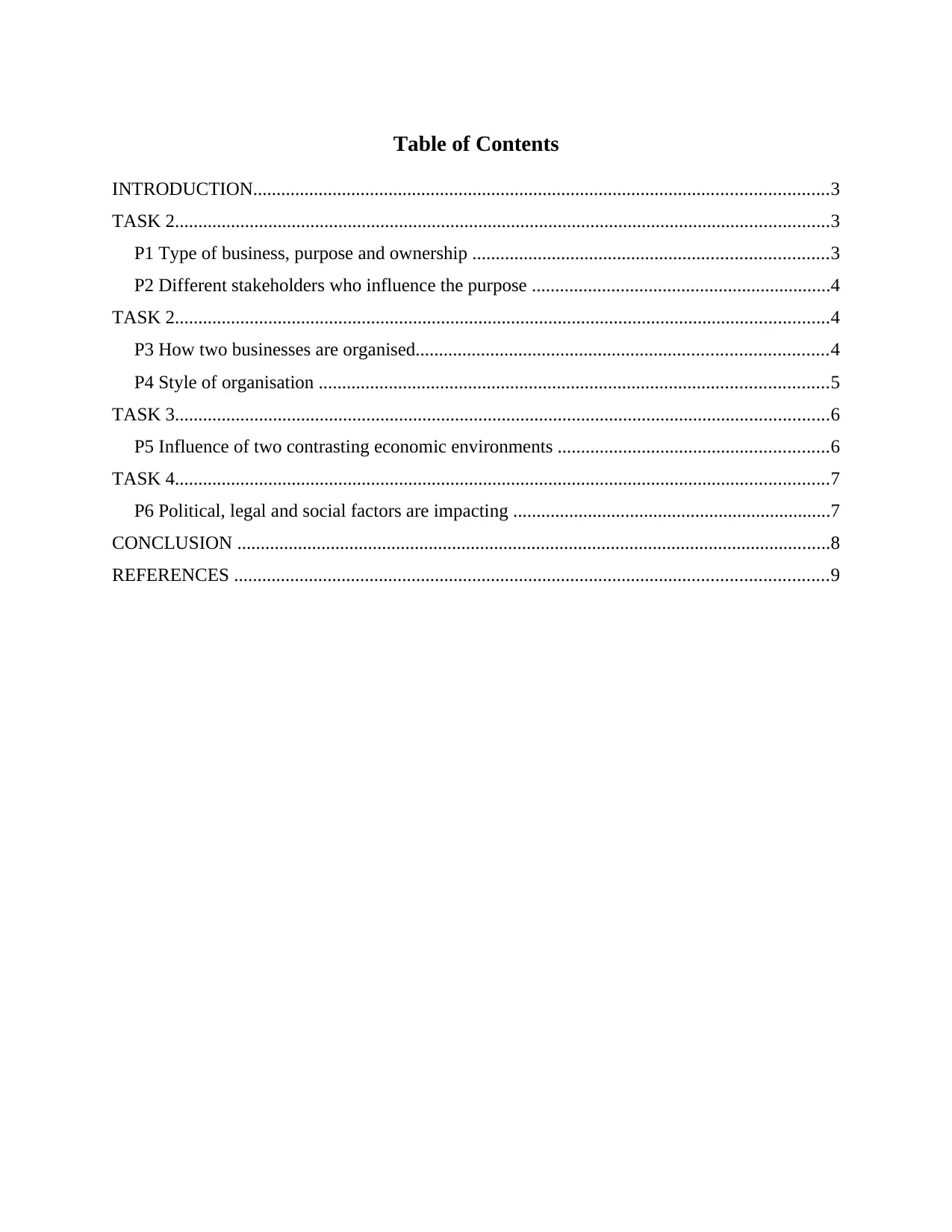
Table of Contents
INTRODUCTION...........................................................................................................................3
TASK 2............................................................................................................................................3
P1 Type of business, purpose and ownership ............................................................................3
P2 Different stakeholders who influence the purpose ................................................................4
TASK 2............................................................................................................................................4
P3 How two businesses are organised........................................................................................4
P4 Style of organisation .............................................................................................................5
TASK 3............................................................................................................................................6
P5 Influence of two contrasting economic environments ..........................................................6
TASK 4............................................................................................................................................7
P6 Political, legal and social factors are impacting ....................................................................7
CONCLUSION ...............................................................................................................................8
REFERENCES ...............................................................................................................................9
INTRODUCTION...........................................................................................................................3
TASK 2............................................................................................................................................3
P1 Type of business, purpose and ownership ............................................................................3
P2 Different stakeholders who influence the purpose ................................................................4
TASK 2............................................................................................................................................4
P3 How two businesses are organised........................................................................................4
P4 Style of organisation .............................................................................................................5
TASK 3............................................................................................................................................6
P5 Influence of two contrasting economic environments ..........................................................6
TASK 4............................................................................................................................................7
P6 Political, legal and social factors are impacting ....................................................................7
CONCLUSION ...............................................................................................................................8
REFERENCES ...............................................................................................................................9

INTRODUCTION
Business environment find out many activity and determine some process related to the
company growth and development in this organisation. The tesco company find out many factor
of business like legal , economic, technological, environment and social factor. This factor
increasing company productivity and finding many sources related to the stakeholder. This
environment including external forces and factor it is aggregative in this nature. This is also
including specific and journals forces like social, political, technological and political factor.
This environment is dynamic nature that keeping the many changing related to technological
condition. It help to rising performances, activity in planning and policy preparation(Klapper
and Parker ., 2011 ).
TASK 2
P1 Type of business, purpose and ownership
Type of Business:
TESCO Stores Limited, commonly known as TESCO, is the second largest retail store
and a national public limited company. It is a profitable business and it is the subsidiary of
American company Walt-Mart. It was founded in 1949. Furthermore as TESCO is a profitable
business it is also in the private sector. Welfare is a local charitable, non-profit organization.
They earn no profit out of their work however do accept forms of donations and fundraisers. The
charity was set up by a church over 100 years ago. It was originally founded in 1894.
Furthermore as it a non-profit business and is giving service it is in the public sector.
Purpose of the business:
A charity is a group of profitable people whose aim is to give a service and help those in
need. Welfare charity provides services which include social work and family support, support
groups and life skill workshops and also a children’s health clinic. They work to keep families
together, and encourage parents to give their children a happier childhood. This is a retail
supermarket and the purposed of this company is to make profit and to supply goods to
customers. It sells general merchandise such as food, drink, clothing and various other items. It
also has services such as insurance, financial services and a mobile telephone network (Arasti
and et. al., 2014).
Business Ownership and level of liability:
Business environment find out many activity and determine some process related to the
company growth and development in this organisation. The tesco company find out many factor
of business like legal , economic, technological, environment and social factor. This factor
increasing company productivity and finding many sources related to the stakeholder. This
environment including external forces and factor it is aggregative in this nature. This is also
including specific and journals forces like social, political, technological and political factor.
This environment is dynamic nature that keeping the many changing related to technological
condition. It help to rising performances, activity in planning and policy preparation(Klapper
and Parker ., 2011 ).
TASK 2
P1 Type of business, purpose and ownership
Type of Business:
TESCO Stores Limited, commonly known as TESCO, is the second largest retail store
and a national public limited company. It is a profitable business and it is the subsidiary of
American company Walt-Mart. It was founded in 1949. Furthermore as TESCO is a profitable
business it is also in the private sector. Welfare is a local charitable, non-profit organization.
They earn no profit out of their work however do accept forms of donations and fundraisers. The
charity was set up by a church over 100 years ago. It was originally founded in 1894.
Furthermore as it a non-profit business and is giving service it is in the public sector.
Purpose of the business:
A charity is a group of profitable people whose aim is to give a service and help those in
need. Welfare charity provides services which include social work and family support, support
groups and life skill workshops and also a children’s health clinic. They work to keep families
together, and encourage parents to give their children a happier childhood. This is a retail
supermarket and the purposed of this company is to make profit and to supply goods to
customers. It sells general merchandise such as food, drink, clothing and various other items. It
also has services such as insurance, financial services and a mobile telephone network (Arasti
and et. al., 2014).
Business Ownership and level of liability:
⊘ This is a preview!⊘
Do you want full access?
Subscribe today to unlock all pages.

Trusted by 1+ million students worldwide
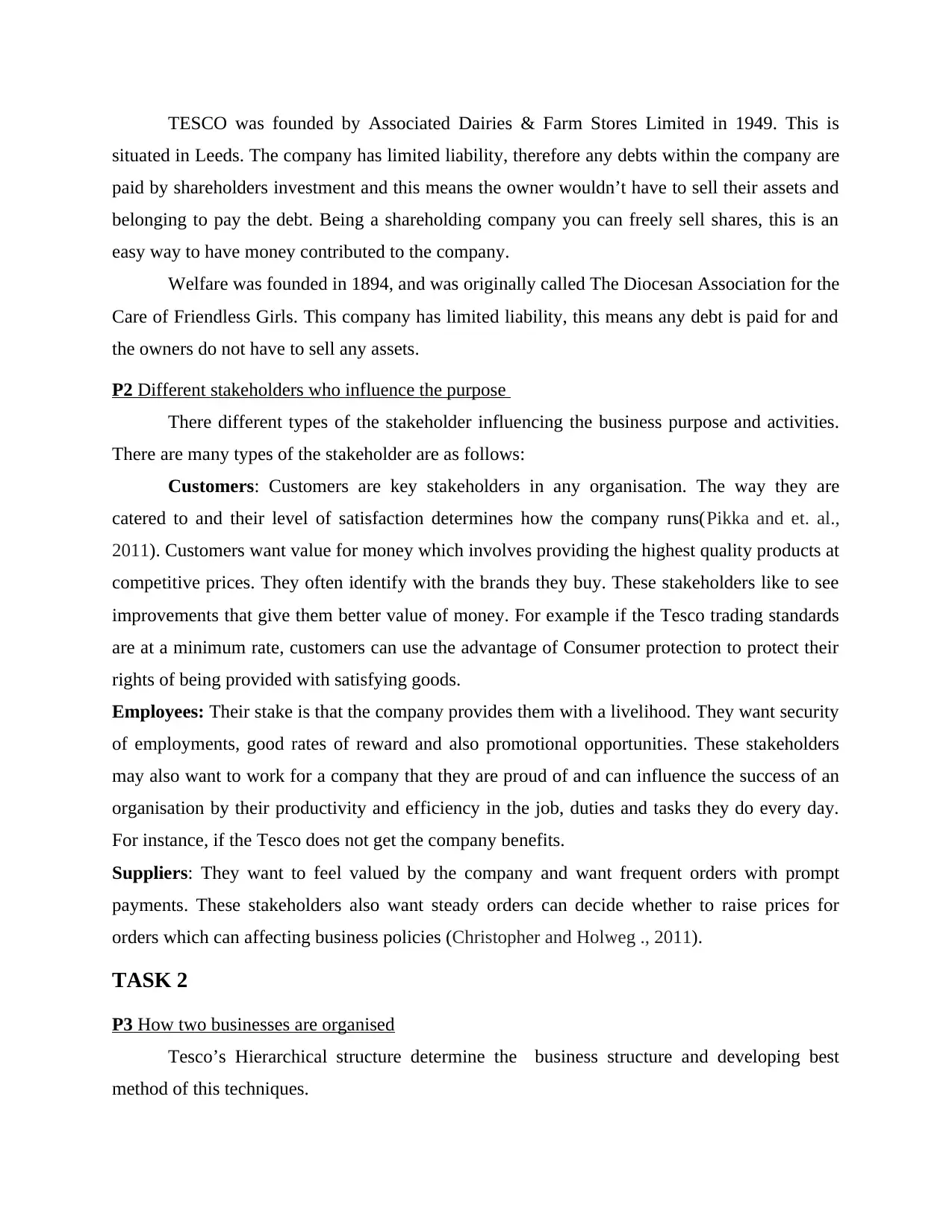
TESCO was founded by Associated Dairies & Farm Stores Limited in 1949. This is
situated in Leeds. The company has limited liability, therefore any debts within the company are
paid by shareholders investment and this means the owner wouldn’t have to sell their assets and
belonging to pay the debt. Being a shareholding company you can freely sell shares, this is an
easy way to have money contributed to the company.
Welfare was founded in 1894, and was originally called The Diocesan Association for the
Care of Friendless Girls. This company has limited liability, this means any debt is paid for and
the owners do not have to sell any assets.
P2 Different stakeholders who influence the purpose
There different types of the stakeholder influencing the business purpose and activities.
There are many types of the stakeholder are as follows:
Customers: Customers are key stakeholders in any organisation. The way they are
catered to and their level of satisfaction determines how the company runs(Pikka and et. al.,
2011). Customers want value for money which involves providing the highest quality products at
competitive prices. They often identify with the brands they buy. These stakeholders like to see
improvements that give them better value of money. For example if the Tesco trading standards
are at a minimum rate, customers can use the advantage of Consumer protection to protect their
rights of being provided with satisfying goods.
Employees: Their stake is that the company provides them with a livelihood. They want security
of employments, good rates of reward and also promotional opportunities. These stakeholders
may also want to work for a company that they are proud of and can influence the success of an
organisation by their productivity and efficiency in the job, duties and tasks they do every day.
For instance, if the Tesco does not get the company benefits.
Suppliers: They want to feel valued by the company and want frequent orders with prompt
payments. These stakeholders also want steady orders can decide whether to raise prices for
orders which can affecting business policies (Christopher and Holweg ., 2011).
TASK 2
P3 How two businesses are organised
Tesco’s Hierarchical structure determine the business structure and developing best
method of this techniques.
situated in Leeds. The company has limited liability, therefore any debts within the company are
paid by shareholders investment and this means the owner wouldn’t have to sell their assets and
belonging to pay the debt. Being a shareholding company you can freely sell shares, this is an
easy way to have money contributed to the company.
Welfare was founded in 1894, and was originally called The Diocesan Association for the
Care of Friendless Girls. This company has limited liability, this means any debt is paid for and
the owners do not have to sell any assets.
P2 Different stakeholders who influence the purpose
There different types of the stakeholder influencing the business purpose and activities.
There are many types of the stakeholder are as follows:
Customers: Customers are key stakeholders in any organisation. The way they are
catered to and their level of satisfaction determines how the company runs(Pikka and et. al.,
2011). Customers want value for money which involves providing the highest quality products at
competitive prices. They often identify with the brands they buy. These stakeholders like to see
improvements that give them better value of money. For example if the Tesco trading standards
are at a minimum rate, customers can use the advantage of Consumer protection to protect their
rights of being provided with satisfying goods.
Employees: Their stake is that the company provides them with a livelihood. They want security
of employments, good rates of reward and also promotional opportunities. These stakeholders
may also want to work for a company that they are proud of and can influence the success of an
organisation by their productivity and efficiency in the job, duties and tasks they do every day.
For instance, if the Tesco does not get the company benefits.
Suppliers: They want to feel valued by the company and want frequent orders with prompt
payments. These stakeholders also want steady orders can decide whether to raise prices for
orders which can affecting business policies (Christopher and Holweg ., 2011).
TASK 2
P3 How two businesses are organised
Tesco’s Hierarchical structure determine the business structure and developing best
method of this techniques.
Paraphrase This Document
Need a fresh take? Get an instant paraphrase of this document with our AI Paraphraser

Tesco’s has a hierarchical organisation structure. Hierarchical structure has several levels
arranged in a treelike construction with the person with most power at the top and the lowest at
the bottom E.G. Managing director at the top all the way to the bottom which is the quality guard
manager and financial accountants. Hierarchical structure is mainly used in big companies like
Tesco. The disadvantages of the hierarchical structure are that if the financial accountants have a
problem it would take its time to get the message to the right person which is the managing
director. So making decisions will take long to make as it would take a long time to go up the
hierarchical structure to put the idea in place. Mainly the first instructions in a hierarchical
structure will have to be the managing director because the person has the most power and be
able to control the company and it will make its way down to the bottom(Lee and et. al., 2012).
Each manager also has a narrow span of control. The advantage of both a flat and tall
organisational structures is that there are fewer managers, so fixed costs of salaries and other
employment-related costs are reduced. There is a shorter chain of command which could lead to
quicker and more precise communication between top levels and lower levels in the organisation.
Also there are wider spans of control. This means that each manager will need to delegate more,
which could result in higher levels of motivation for subordinate employees. However, there are
also a few disadvantages to a flat organisational structure. There are greater workloads and
higher stress levels for each member of staff.
P4 Style of organisation
Asda is a company that wants to sell all of the best products to customers and be one of
the best selling supermarkets in the UK. It is a Public Limited company which means that
shareholders own the company which means the ownership moves around a lot (Haidar ., 2012).
Asda is a private limited company and was founded as an Associated Dairies & Farm Stores
Limited in 1949 in Leeds. Also the company offer shares to the public. Asda is a tertiary
business. This means that it is a company that sell the products that have been made.
Asda is a nationwide company but is known as WAL-MART in every other company.
Asda is the Second largest chain of Supermarket in the UK after Tesco. There Products range
from food, clothing, general merchandise, toys and financial services. It also has its own mobile
telephone network (via Vodafone network). Its head office is bases in Asda house in Leeds, West
arranged in a treelike construction with the person with most power at the top and the lowest at
the bottom E.G. Managing director at the top all the way to the bottom which is the quality guard
manager and financial accountants. Hierarchical structure is mainly used in big companies like
Tesco. The disadvantages of the hierarchical structure are that if the financial accountants have a
problem it would take its time to get the message to the right person which is the managing
director. So making decisions will take long to make as it would take a long time to go up the
hierarchical structure to put the idea in place. Mainly the first instructions in a hierarchical
structure will have to be the managing director because the person has the most power and be
able to control the company and it will make its way down to the bottom(Lee and et. al., 2012).
Each manager also has a narrow span of control. The advantage of both a flat and tall
organisational structures is that there are fewer managers, so fixed costs of salaries and other
employment-related costs are reduced. There is a shorter chain of command which could lead to
quicker and more precise communication between top levels and lower levels in the organisation.
Also there are wider spans of control. This means that each manager will need to delegate more,
which could result in higher levels of motivation for subordinate employees. However, there are
also a few disadvantages to a flat organisational structure. There are greater workloads and
higher stress levels for each member of staff.
P4 Style of organisation
Asda is a company that wants to sell all of the best products to customers and be one of
the best selling supermarkets in the UK. It is a Public Limited company which means that
shareholders own the company which means the ownership moves around a lot (Haidar ., 2012).
Asda is a private limited company and was founded as an Associated Dairies & Farm Stores
Limited in 1949 in Leeds. Also the company offer shares to the public. Asda is a tertiary
business. This means that it is a company that sell the products that have been made.
Asda is a nationwide company but is known as WAL-MART in every other company.
Asda is the Second largest chain of Supermarket in the UK after Tesco. There Products range
from food, clothing, general merchandise, toys and financial services. It also has its own mobile
telephone network (via Vodafone network). Its head office is bases in Asda house in Leeds, West
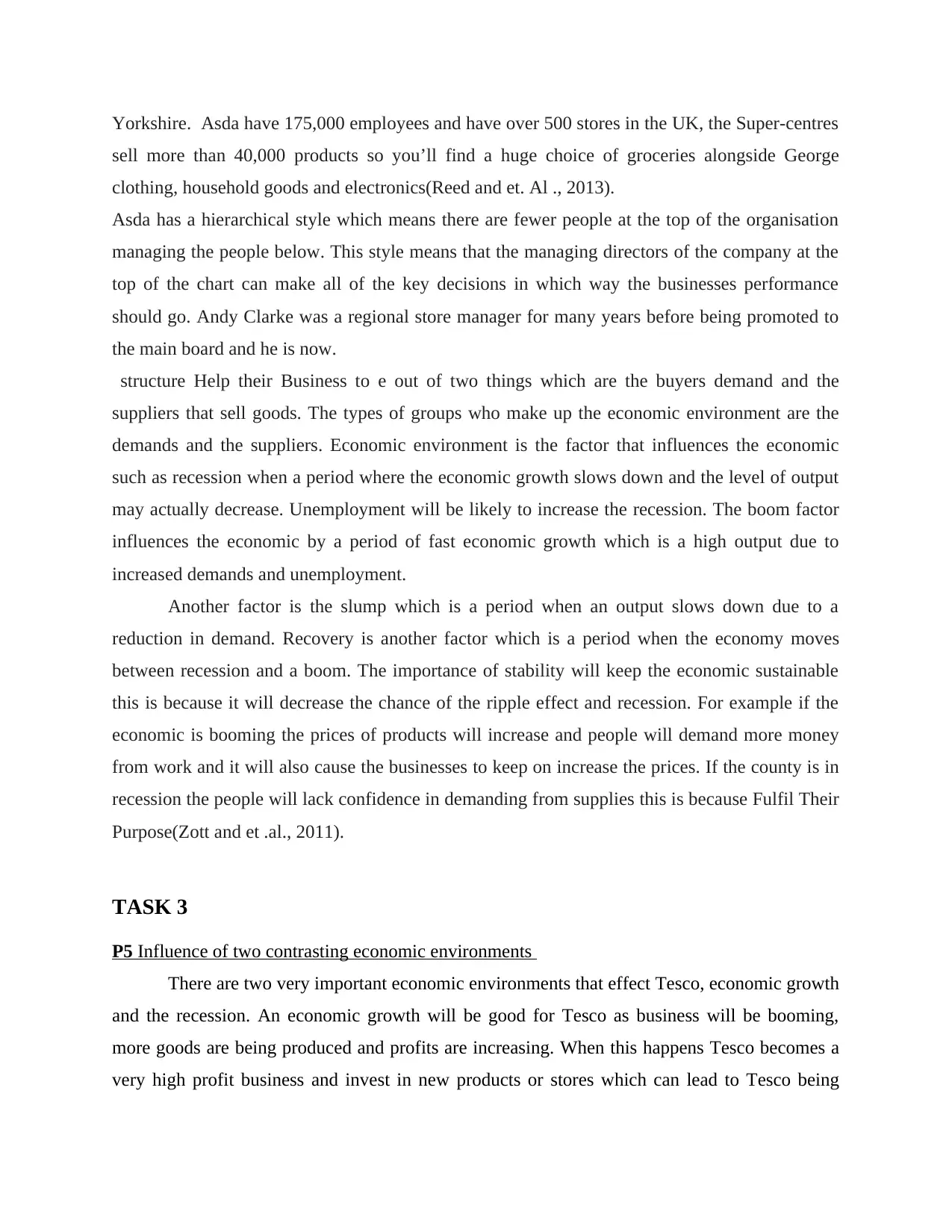
Yorkshire. Asda have 175,000 employees and have over 500 stores in the UK, the Super-centres
sell more than 40,000 products so you’ll find a huge choice of groceries alongside George
clothing, household goods and electronics(Reed and et. Al ., 2013).
Asda has a hierarchical style which means there are fewer people at the top of the organisation
managing the people below. This style means that the managing directors of the company at the
top of the chart can make all of the key decisions in which way the businesses performance
should go. Andy Clarke was a regional store manager for many years before being promoted to
the main board and he is now.
structure Help their Business to e out of two things which are the buyers demand and the
suppliers that sell goods. The types of groups who make up the economic environment are the
demands and the suppliers. Economic environment is the factor that influences the economic
such as recession when a period where the economic growth slows down and the level of output
may actually decrease. Unemployment will be likely to increase the recession. The boom factor
influences the economic by a period of fast economic growth which is a high output due to
increased demands and unemployment.
Another factor is the slump which is a period when an output slows down due to a
reduction in demand. Recovery is another factor which is a period when the economy moves
between recession and a boom. The importance of stability will keep the economic sustainable
this is because it will decrease the chance of the ripple effect and recession. For example if the
economic is booming the prices of products will increase and people will demand more money
from work and it will also cause the businesses to keep on increase the prices. If the county is in
recession the people will lack confidence in demanding from supplies this is because Fulfil Their
Purpose(Zott and et .al., 2011).
TASK 3
P5 Influence of two contrasting economic environments
There are two very important economic environments that effect Tesco, economic growth
and the recession. An economic growth will be good for Tesco as business will be booming,
more goods are being produced and profits are increasing. When this happens Tesco becomes a
very high profit business and invest in new products or stores which can lead to Tesco being
sell more than 40,000 products so you’ll find a huge choice of groceries alongside George
clothing, household goods and electronics(Reed and et. Al ., 2013).
Asda has a hierarchical style which means there are fewer people at the top of the organisation
managing the people below. This style means that the managing directors of the company at the
top of the chart can make all of the key decisions in which way the businesses performance
should go. Andy Clarke was a regional store manager for many years before being promoted to
the main board and he is now.
structure Help their Business to e out of two things which are the buyers demand and the
suppliers that sell goods. The types of groups who make up the economic environment are the
demands and the suppliers. Economic environment is the factor that influences the economic
such as recession when a period where the economic growth slows down and the level of output
may actually decrease. Unemployment will be likely to increase the recession. The boom factor
influences the economic by a period of fast economic growth which is a high output due to
increased demands and unemployment.
Another factor is the slump which is a period when an output slows down due to a
reduction in demand. Recovery is another factor which is a period when the economy moves
between recession and a boom. The importance of stability will keep the economic sustainable
this is because it will decrease the chance of the ripple effect and recession. For example if the
economic is booming the prices of products will increase and people will demand more money
from work and it will also cause the businesses to keep on increase the prices. If the county is in
recession the people will lack confidence in demanding from supplies this is because Fulfil Their
Purpose(Zott and et .al., 2011).
TASK 3
P5 Influence of two contrasting economic environments
There are two very important economic environments that effect Tesco, economic growth
and the recession. An economic growth will be good for Tesco as business will be booming,
more goods are being produced and profits are increasing. When this happens Tesco becomes a
very high profit business and invest in new products or stores which can lead to Tesco being
⊘ This is a preview!⊘
Do you want full access?
Subscribe today to unlock all pages.

Trusted by 1+ million students worldwide

more profitable business wise. Profits are increased during economic growth as customers want
more products; they have the money to spend and choose to spend it in Tesco’s. This leads to a
much higher product demand, which affects the primary sector – farmers. Farmers will need
more animals and more farm hands effectively as they are producing for a large company and if
the demands aren’t met they will lose business (Cavalcante and et .al., 2011).
For example during an economic boom people tend to buy luxuries as they have the
spare money to spend, so a customer instead of buying a ready meal might decide they will have
a steak instead and there could be a large amount of Tesco’s customers with the same thought
process, this will in turn mean that company will order a large amount of steak’s from the
farmers and if they can’t supply this they will lose Tesco’s business and also Tesco won’t be able
to meet its customer demands and could also lose business. People will also stop buying Tesco
value products such as cereal, canned goods and start buying branded names as they can afford it
and we are a brand loving country which means that Tesco generate more money as people are
buying the much more expensive goods. In the Tesco had a reasonable growth in profit even in a
challenging economic environment.
TASK 4
P6 Political, legal and social factors are impacting
Political stability is usually defined as the state of peace that is normal experienced in a
country from the activities from the government and also the government in this situation will
make decisions and keeping the best interests in mind for people (Kian Chong and et .al., 2011).
The legal impacts are that Tesco must follow the law, and an example of this is the trade
description act, this is where the product most be described accurately otherwise it can cause an
issue and an example of this the big issue with meat earlier this year, so it is extremely important
that you describe the product well and accurately if not then the trading standards will have no
other choice but to get involved.
The social impacts that company may face are the difficulty to recruit the right people
for the job in the stores or the offices depending on where they will be based, also most of the
workers that are in the stores are an unskilled workers on the minimum wage given .
more products; they have the money to spend and choose to spend it in Tesco’s. This leads to a
much higher product demand, which affects the primary sector – farmers. Farmers will need
more animals and more farm hands effectively as they are producing for a large company and if
the demands aren’t met they will lose business (Cavalcante and et .al., 2011).
For example during an economic boom people tend to buy luxuries as they have the
spare money to spend, so a customer instead of buying a ready meal might decide they will have
a steak instead and there could be a large amount of Tesco’s customers with the same thought
process, this will in turn mean that company will order a large amount of steak’s from the
farmers and if they can’t supply this they will lose Tesco’s business and also Tesco won’t be able
to meet its customer demands and could also lose business. People will also stop buying Tesco
value products such as cereal, canned goods and start buying branded names as they can afford it
and we are a brand loving country which means that Tesco generate more money as people are
buying the much more expensive goods. In the Tesco had a reasonable growth in profit even in a
challenging economic environment.
TASK 4
P6 Political, legal and social factors are impacting
Political stability is usually defined as the state of peace that is normal experienced in a
country from the activities from the government and also the government in this situation will
make decisions and keeping the best interests in mind for people (Kian Chong and et .al., 2011).
The legal impacts are that Tesco must follow the law, and an example of this is the trade
description act, this is where the product most be described accurately otherwise it can cause an
issue and an example of this the big issue with meat earlier this year, so it is extremely important
that you describe the product well and accurately if not then the trading standards will have no
other choice but to get involved.
The social impacts that company may face are the difficulty to recruit the right people
for the job in the stores or the offices depending on where they will be based, also most of the
workers that are in the stores are an unskilled workers on the minimum wage given .
Paraphrase This Document
Need a fresh take? Get an instant paraphrase of this document with our AI Paraphraser
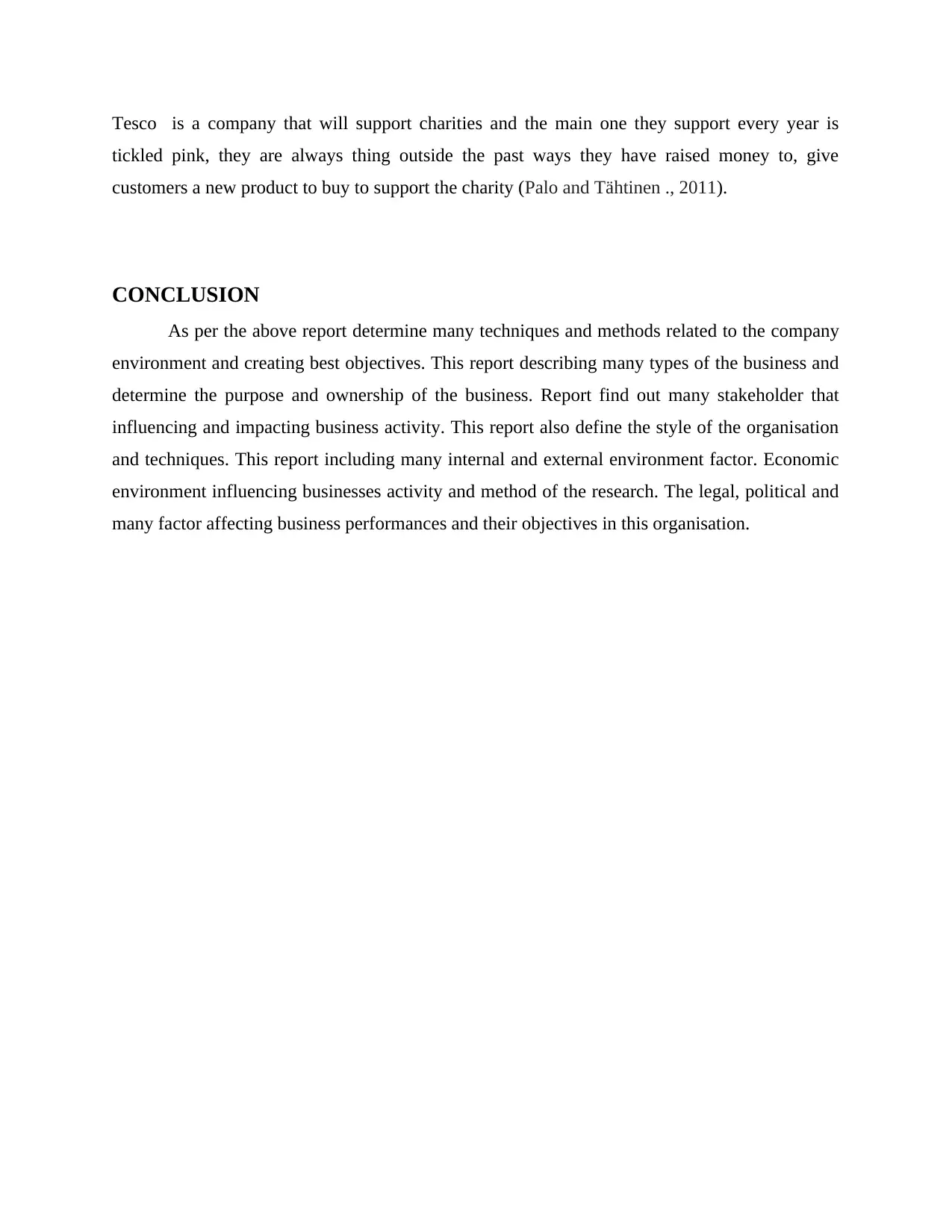
Tesco is a company that will support charities and the main one they support every year is
tickled pink, they are always thing outside the past ways they have raised money to, give
customers a new product to buy to support the charity (Palo and Tähtinen ., 2011).
CONCLUSION
As per the above report determine many techniques and methods related to the company
environment and creating best objectives. This report describing many types of the business and
determine the purpose and ownership of the business. Report find out many stakeholder that
influencing and impacting business activity. This report also define the style of the organisation
and techniques. This report including many internal and external environment factor. Economic
environment influencing businesses activity and method of the research. The legal, political and
many factor affecting business performances and their objectives in this organisation.
tickled pink, they are always thing outside the past ways they have raised money to, give
customers a new product to buy to support the charity (Palo and Tähtinen ., 2011).
CONCLUSION
As per the above report determine many techniques and methods related to the company
environment and creating best objectives. This report describing many types of the business and
determine the purpose and ownership of the business. Report find out many stakeholder that
influencing and impacting business activity. This report also define the style of the organisation
and techniques. This report including many internal and external environment factor. Economic
environment influencing businesses activity and method of the research. The legal, political and
many factor affecting business performances and their objectives in this organisation.
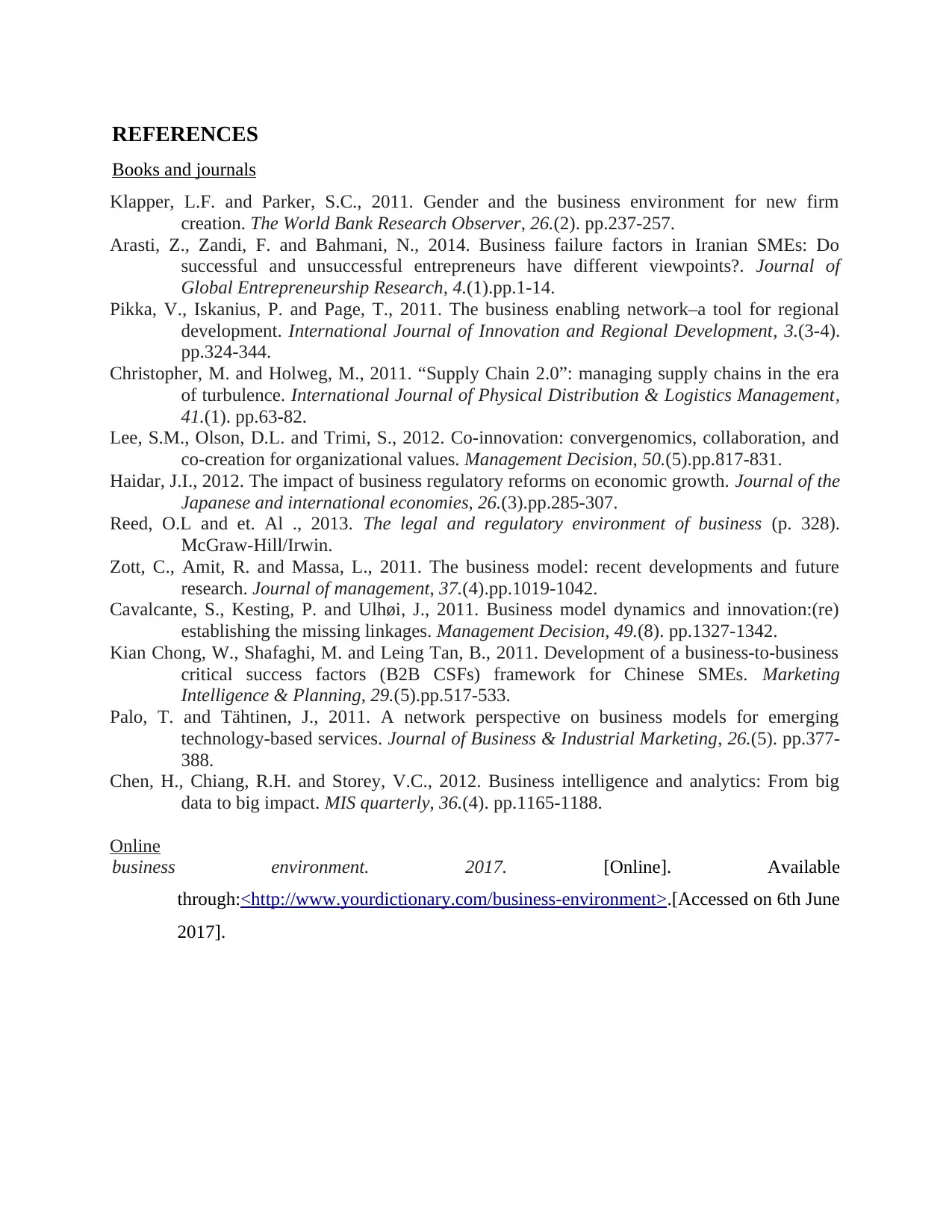
REFERENCES
Books and journals
Klapper, L.F. and Parker, S.C., 2011. Gender and the business environment for new firm
creation. The World Bank Research Observer, 26.(2). pp.237-257.
Arasti, Z., Zandi, F. and Bahmani, N., 2014. Business failure factors in Iranian SMEs: Do
successful and unsuccessful entrepreneurs have different viewpoints?. Journal of
Global Entrepreneurship Research, 4.(1).pp.1-14.
Pikka, V., Iskanius, P. and Page, T., 2011. The business enabling network–a tool for regional
development. International Journal of Innovation and Regional Development, 3.(3-4).
pp.324-344.
Christopher, M. and Holweg, M., 2011. “Supply Chain 2.0”: managing supply chains in the era
of turbulence. International Journal of Physical Distribution & Logistics Management,
41.(1). pp.63-82.
Lee, S.M., Olson, D.L. and Trimi, S., 2012. Co-innovation: convergenomics, collaboration, and
co-creation for organizational values. Management Decision, 50.(5).pp.817-831.
Haidar, J.I., 2012. The impact of business regulatory reforms on economic growth. Journal of the
Japanese and international economies, 26.(3).pp.285-307.
Reed, O.L and et. Al ., 2013. The legal and regulatory environment of business (p. 328).
McGraw-Hill/Irwin.
Zott, C., Amit, R. and Massa, L., 2011. The business model: recent developments and future
research. Journal of management, 37.(4).pp.1019-1042.
Cavalcante, S., Kesting, P. and Ulhøi, J., 2011. Business model dynamics and innovation:(re)
establishing the missing linkages. Management Decision, 49.(8). pp.1327-1342.
Kian Chong, W., Shafaghi, M. and Leing Tan, B., 2011. Development of a business-to-business
critical success factors (B2B CSFs) framework for Chinese SMEs. Marketing
Intelligence & Planning, 29.(5).pp.517-533.
Palo, T. and Tähtinen, J., 2011. A network perspective on business models for emerging
technology-based services. Journal of Business & Industrial Marketing, 26.(5). pp.377-
388.
Chen, H., Chiang, R.H. and Storey, V.C., 2012. Business intelligence and analytics: From big
data to big impact. MIS quarterly, 36.(4). pp.1165-1188.
Online
business environment. 2017. [Online]. Available
through:<http://www.yourdictionary.com/business-environment>.[Accessed on 6th June
2017].
Books and journals
Klapper, L.F. and Parker, S.C., 2011. Gender and the business environment for new firm
creation. The World Bank Research Observer, 26.(2). pp.237-257.
Arasti, Z., Zandi, F. and Bahmani, N., 2014. Business failure factors in Iranian SMEs: Do
successful and unsuccessful entrepreneurs have different viewpoints?. Journal of
Global Entrepreneurship Research, 4.(1).pp.1-14.
Pikka, V., Iskanius, P. and Page, T., 2011. The business enabling network–a tool for regional
development. International Journal of Innovation and Regional Development, 3.(3-4).
pp.324-344.
Christopher, M. and Holweg, M., 2011. “Supply Chain 2.0”: managing supply chains in the era
of turbulence. International Journal of Physical Distribution & Logistics Management,
41.(1). pp.63-82.
Lee, S.M., Olson, D.L. and Trimi, S., 2012. Co-innovation: convergenomics, collaboration, and
co-creation for organizational values. Management Decision, 50.(5).pp.817-831.
Haidar, J.I., 2012. The impact of business regulatory reforms on economic growth. Journal of the
Japanese and international economies, 26.(3).pp.285-307.
Reed, O.L and et. Al ., 2013. The legal and regulatory environment of business (p. 328).
McGraw-Hill/Irwin.
Zott, C., Amit, R. and Massa, L., 2011. The business model: recent developments and future
research. Journal of management, 37.(4).pp.1019-1042.
Cavalcante, S., Kesting, P. and Ulhøi, J., 2011. Business model dynamics and innovation:(re)
establishing the missing linkages. Management Decision, 49.(8). pp.1327-1342.
Kian Chong, W., Shafaghi, M. and Leing Tan, B., 2011. Development of a business-to-business
critical success factors (B2B CSFs) framework for Chinese SMEs. Marketing
Intelligence & Planning, 29.(5).pp.517-533.
Palo, T. and Tähtinen, J., 2011. A network perspective on business models for emerging
technology-based services. Journal of Business & Industrial Marketing, 26.(5). pp.377-
388.
Chen, H., Chiang, R.H. and Storey, V.C., 2012. Business intelligence and analytics: From big
data to big impact. MIS quarterly, 36.(4). pp.1165-1188.
Online
business environment. 2017. [Online]. Available
through:<http://www.yourdictionary.com/business-environment>.[Accessed on 6th June
2017].
⊘ This is a preview!⊘
Do you want full access?
Subscribe today to unlock all pages.

Trusted by 1+ million students worldwide
1 out of 9
Related Documents
Your All-in-One AI-Powered Toolkit for Academic Success.
+13062052269
info@desklib.com
Available 24*7 on WhatsApp / Email
![[object Object]](/_next/static/media/star-bottom.7253800d.svg)
Unlock your academic potential
Copyright © 2020–2025 A2Z Services. All Rights Reserved. Developed and managed by ZUCOL.




